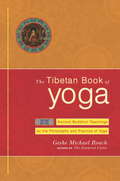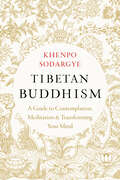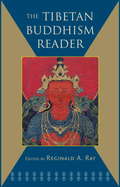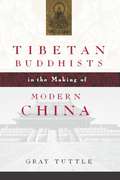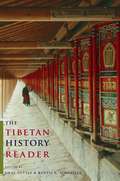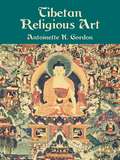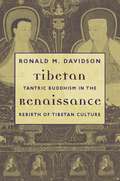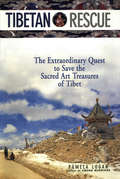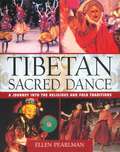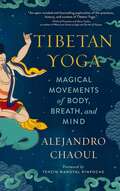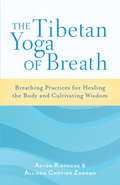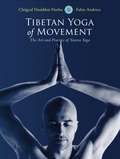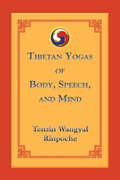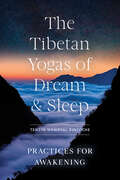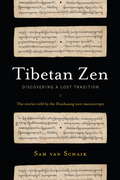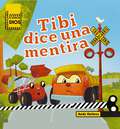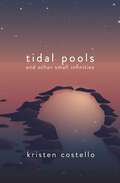- Table View
- List View
The Tibetan Book of Yoga
by Geshe Michael RoachYoga came to Tibet from India more than a thousand years ago, and it was quickly absorbed into the culture's rich traditions. In this small book readers will discover Heart Yoga, which developed over the centuries in the Gelukpa tradition of the Dalai Lamas. The program presented here combines popular yoga exercises wtih special Tibetan poses, and methods of working from the inside to give a healthy and a happy heart. Roach discovered a number of previously unknown Tibetan works on yoga in the course of his ongoing efforts to find and preserve ancient Tibetan Buddhist texts. He discusses the ideas and insights presented in these texts and places them within the context of the Buddhist tradition. To help readers incorporate this ancient wisdom in their daily lives, he provides a specific regime of yoga postures and meditations. Combining instructive illustrations with the unique philosophical underpinnings of the Buddhist approach, Geshe Roach has created a unique program for yoga on a physical and spiritual level.
Tibetan Buddhism: A Guide to Contemplation, Meditation, and Transforming Your Mind
by Khenpo SodargyeYour genuine, go-to overview of Tibetan Buddhism from a leading contemporary teacher who has traversed the wisdom pathThis guide shares Tibetan Buddhist insight and tools that will benefit everyone in transforming their mind. Khenpo Sodargye, who has attracted hundreds of thousands of students worldwide with his concise, easy-to-follow teaching style, sketches the big picture of the Mahayana path in straightforward language with stories relevant to everyday life. He draws on authentic texts and teachings by renowned Buddhist masters to explain complex concepts like:The Four Dharma SealsFaithBodhichittaThe Three Supreme MethodsThe Two TruthsRebirth and karmaSpiritual teachersThe Great Perfection This book introduces a systematic approach to studying Mahayana Buddhism. Through proper listening, contemplating, and meditating, we can generate the wisdom that enables us to transform suffering and happiness into enlightenment and to cultivate the compassion that inspires us to bring enlightenment to everyone, which is the essence of Mahayana Buddhism. This book is the perfect companion for anyone wanting to learn more about the basics of Mahayana Buddhism or to strengthen the foundations of their spiritual practice.
Tibetan Buddhism from the Ground Up: A Practical Approach for Modern Life
by B. Alan Wallace Steven WilhelmAs long as our minds are dominated by the conditions of the external world, we are bound to remain in a state of dissatisfaction, always vulnerable to grief and fear. How then can we develop an inner sense of well-being and redefine our relationship to a world that seems unavoidably painful and unkind? Many have found a practical answer to that question in the teachings of Tibetan Buddhism. Here at last is an organized overview of these teachings, beginning with the basic themes of the sutras--the general discourses of the Buddha--and continuing through the esoteric concepts and advanced practices of Tantra. Unlike other introductions to Tibetan Buddhism, this accessible, enjoyable work doesn't stop with theory and history, but relates timeless spiritual principles to the pressing issues of modern life, both in terms of our daily experience and our uniquely Western world view. This fascinating, highly readable book asks neither unquestioning faith nor blind obedience to abstract concepts or religious beliefs. Rather, it challenges us to question and investigate life's issues for ourselves in the light of an ancient and effective approach to the sufferings and joys of the human condition.
Tibetan Buddhism in Diaspora: Cultural re-signification in practice and institutions (Routledge Critical Studies in Buddhism)
by Ana Cristina LopesThe imperialist ambitions of China – which invaded Tibet in the late 1940s – have sparked the spectacular spread of Tibetan Buddhism worldwide, and especially in western countries. This work is a study on the malleability of a particular Buddhist tradition; on its adaptability in new contexts. The book analyses the nature of the Tibetan Buddhism in the Diaspora. It examines how the re-signification of Tibetan Buddhist practices and organizational structures in the present refers back to the dismantlement of the Tibetan state headed by the Dalai Lama and the fragmentation of Tibetan Buddhist religious organizations in general. It includes extensive multi-sited fieldwork conducted in the United States, Brazil, Europe, and Asia and a detailed analysis of contemporary documents relating to the global spread of Tibetan Buddhism. The author demonstrates that there is a "de-institutionalized" and "de-territorialized" project of political power and religious organization, which, among several other consequences, engenders the gradual "autonomization" of lamas and lineages inside the religious field of Tibetan Buddhism. Thus, a spectre of these previous institutions continues to exist outside their original contexts, and they are continually activated in ever-new settings. Using a combination of two different academic traditions – namely, the Brazilian anthropological tradition and the American Buddhist studies tradition – it investigates the "process of cultural re-signification" of Tibetan Buddhism in the context of its Diaspora. Thus, it will be a valuable resource to students and scholars of Asian Religion, Asian Studies and Buddhism.
The Tibetan Buddhism Reader
by Reginald A. RayHere is a portable collection of inspiring readings from the revered masters of Tibetan Buddhism. The Tibetan Buddhism Reader includes quotations from major lineage figures from the past such as Padmasambhava, Atisha, Sakya Pandita, Marpa, Milarepa, and Tsongkhapa. Also featured are the writings of masters from contemporary times including the Dalai Lama, Dudjom Rinpoche, Khyentse Rinpoche, Sakya Tridzin, Chögyam Trungpa, and others. Topics include cultivating compassion, letting go of ego, learning to become more alert and present in our lives, and developing a clear perception of our own true nature.
Tibetan Buddhists in the Making of Modern China
by Gray TuttleOver the past century and with varying degrees of success, China has tried to integrate Tibet into the modern Chinese nation-state. In this groundbreaking work, Gray Tuttle reveals the surprising role Buddhism and Buddhist leaders played in the development of the modern Chinese state and in fostering relations between Tibet and China from the Republican period (1912-1949) to the early years of Communist rule. Beyond exploring interactions between Buddhists and politicians in Tibet and China, Tuttle offers new insights on the impact of modern ideas of nationalism, race, and religion in East Asia.After the fall of the Qing dynasty in 1911, the Chinese Nationalists, without the traditional religious authority of the Manchu Emperor, promoted nationalism and racial unity in an effort to win support among Tibetans. Once this failed, Chinese politicians appealed to a shared Buddhist heritage. This shift in policy reflected the late-nineteenth-century academic notion of Buddhism as a unified world religion, rather than a set of competing and diverse Asian religious practices. While Chinese politicians hoped to gain Tibetan loyalty through religion, the promotion of a shared Buddhist heritage allowed Chinese Buddhists and Tibetan political and religious leaders to pursue their goals. During the 1930s and 1940s, Tibetan Buddhist ideas and teachers enjoyed tremendous popularity within a broad spectrum of Chinese society and especially among marginalized Chinese Buddhists. Even when relationships between the elite leadership between the two nations broke down, religious and cultural connections remained strong. After the Communists seized control, they continued to exploit this link when exerting control over Tibet by force in the 1950s. And despite being an avowedly atheist regime, with the exception of the Cultural Revolution, the Chinese communist government has continued to recognize and support many elements of Tibetan religious, if not political, culture.Tuttle's study explores the role of Buddhism in the formation of modern China and its relationship to Tibet through the lives of Tibetan and Chinese Buddhists and politicians and by drawing on previously unexamined archival and governmental materials, as well as personal memoirs of Chinese politicians and Buddhist monks, and ephemera from religious ceremonies.
Tibetan Calligraphy
by Sarah Harding Sanje ElliottIn Tibetan Calligraphy, Sanje Elliott shows us how to capture the elegance and grace of Tibetan calligraphy without prior knowledge of either Tibetan language or calligraphy. This beautiful book includes many prayers, mantras, and seed syllables to copy and study. Perfect for practitioners, artists, and anyone interested in the Tibetan language.
The Tibetan History Reader
by Gray Tuttle Kurtis SchaefferCovering the social, cultural, and political development of Tibet from the seventh century to the modern period, this resource reproduces essential, hard-to-find essays from the past fifty years of Tibetan studies, along with several new contributions. Beginning with Tibet's emergence as a regional power and concluding with its profound contemporary transformations, the collection is both a general and specific history, connecting the actions of individuals, communities, and institutions to broader historical trends shaping Asia and the world. With contributions from American, French, German, Italian, Chinese, Japanese, and Tibetan scholars, the anthology reflects the international character of Tibetan studies and its multiple, interdisciplinary perspectives. By far the most concise scholarly anthology on Tibetan civilization in any Western language, this reader draws a clear portrait of Tibet's history, its relation to its neighbors, and its role in world affairs.
Tibetan Religious Art
by Antoinette K. GordonOver 50 years after its first publication this work remains a vital and useful survey. Assembled by an anthropologist at the American Museum of Natural History, it features artwork from that institution's extensive collections, in addition to seldom-seen Tibetan artifacts from other museums and private collections. Following an informative overview of the intrinsic relationship of Buddist deities to Tibetan art, a lavish assortment of illustrations includes temple paintings, books, wood blocks, ritual objects, robes, masks, metal work, musical instruments, jewelry, butter sculpture, sand mandalas, and calligraphy. Each item is described in detail, with explanations of the methods and materials used in its creation. Preface. Bibliography. Index. 92 black-and-white illustrations.
Tibetan Renaissance: Tantric Buddhism in the Rebirth of Tibetan Culture
by Ronald DavidsonHow did a society on the edge of collapse and dominated by wandering bands of armed men give way to a vibrant Buddhist culture, led by yogins and scholars? Ronald M. Davidson explores how the translation and spread of esoteric Buddhist texts dramatically shaped Tibetan society and led to its rise as the center of Buddhist culture throughout Asia, replacing India as the perceived source of religious ideology and tradition. During the Tibetan Renaissance (950-1200 C.E.), monks and yogins translated an enormous number of Indian Buddhist texts. They employed the evolving literature and practices of esoteric Buddhism as the basis to reconstruct Tibetan religious, cultural, and political institutions. Many translators achieved the de facto status of feudal lords and while not always loyal to their Buddhist vows, these figures helped solidify political power in the hands of religious authorities and began a process that led to the Dalai Lama's theocracy. Davidson's vivid portraits of the monks, priests, popular preachers, yogins, and aristocratic clans who changed Tibetan society and culture further enhance his perspectives on the tensions and transformations that characterized medieval Tibet.
Tibetan Rescue
by Pamela LoganThe culture and artifacts of Tibet,like those of other remote indigenoussocieties, are under siege by the relentless modern world. The fate of monasteries in Tibet has been a subject of concern to many in the West; butuntil Tibetan Rescue little specific information had been published. As president of a nongovernmental organization that brings foreign aid intoTibet, Pamela Logan brings a first-hand account of h er journey through Tibet,as she evolves from solo traveler to expedition leader. Her mission: to savethe precious ancient murals of Pewar Monastery. To reach her goal she travels a long and circuitous path raising funds, getting permission from the Chinese bureaucracy, assembling an international team, and leading fourexpeditions by bus, truck, and horse caravan to Pewar Monastery. Along theway she meets a memorable parade of characters, overcomes bureaucrats andblizzards, and survives a brutal attack by a pack of Tibetan dogs. Her book is an insider's look at a remote and little known part of Tibet, her story an inspiration to those who cherish challenge and adventure.
Tibetan Rescue
by Pamela LoganThe culture and artifacts of Tibet,like those of other remote indigenoussocieties, are under siege by the relentless modern world. The fate of monasteries in Tibet has been a subject of concern to many in the West; butuntil Tibetan Rescue little specific information had been published. As president of a nongovernmental organization that brings foreign aid intoTibet, Pamela Logan brings a first-hand account of h er journey through Tibet,as she evolves from solo traveler to expedition leader. Her mission: to savethe precious ancient murals of Pewar Monastery. To reach her goal she travels a long and circuitous path raising funds, getting permission from the Chinese bureaucracy, assembling an international team, and leading fourexpeditions by bus, truck, and horse caravan to Pewar Monastery. Along theway she meets a memorable parade of characters, overcomes bureaucrats andblizzards, and survives a brutal attack by a pack of Tibetan dogs. Her book is an insider's look at a remote and little known part of Tibet, her story an inspiration to those who cherish challenge and adventure.
Tibetan Rescue
by Pamela LoganThe culture and artifacts of Tibet, like those of other remote indigenous societies, are under siege by the relentless modern world. The fate of monasteries in Tibet has been a subject of concern to many in the West; but until Tibetan Rescue little specific information had been published. As president of a non-governmental organization that brings foreign aid into Tibet, Pamela Logan brings a first-hand account of her journey through Tibet.Pamela evolves from solo traveler to expedition leader on her mission: to save the precious ancient murals of Pewar Monastery. To reach her goal she travels a long and circuitous path raising funds, getting permission from the Chinese bureaucracy, assembling an international team, and leading four expeditions by bus, truck, and horse caravan to Pewar Monastery. Along the way she meets a memorable parade of characters, overcomes bureaucrats and blizzards, and survives a brutal attack by a pack of Tibetan dogs. Her book is an insider's look at a remote and little known part of Tibet, her story an inspiration to those who cherish challenge and adventure.
Tibetan Sacred Dance: A Journey into the Religious and Folk Traditions
by Ellen PearlmanThe first book to explore the significance and symbolism of the sacred and secular ritual dances of Tibetan Buddhism.• Lavishly illustrated with color and rare historic photographs depicting the dances, costumes, and masks.• Looks at both sacred (cham) and folk (achi lhamo) forms and their role in the development, practice, and culture of Tibetan Buddhism.From the time Buddhism entered the mythical land of the snows, Tibetans have expressed their spiritual devotion and celebrated their culture with dance. Only since the diaspora of the Tibetan people have outsiders witnessed these performances, and when they do, no one explains why these dances exist and what they really mean. Ellen Pearlman, who studied with Lobsang Samten, the ritual dance master of the Dalai Lama's Namgyal monastery in India, set out to discover the meaning behind these practices. She found the story of the indigenous shamanistic Bon religion being superseded by Buddhism--a story full of dangerous and illicit liaisons, brilliant visions, secret teachings, betrayals, and unrevealed yogic practices. Pearlman examines the four lineages that developed sacred cham--the secret ritual dances of Tibet's Buddhist monks--and achi lhamo storytelling folk dance and opera. She describes the mental and physical process of preparing for these dances, the meaning of the iconography of the costumes and masks, the spectrum of accompanying music, and the actual dance steps as recorded in a choreography book dating back to the Fifth Dalai Lama in 1647. Beautiful color photographs from the Tibetan Institute of Performing Arts and Pearlman's own images of touring monastic troupes complement the rare historic black-and-white photos from the collections of Sir Charles Bell, chief of the British Mission in Tibet during the life of the Thirteenth Dalai Lama.
Tibetan Shamanism: Ecstasy and Healing
by Larry PetersReflecting sixteen years of intensive fieldwork, this book is a rich chronicle of the daily lives, belief systems, and healing rituals of four highly revered Tibetan shamans forced into exile by the Chinese invasion during the 1950s. Larry Peters lived and studied closely with the shamans in Nepal, learning their belief system, observing and participating in their rituals, and introducing many dozens of students to their worldview. Including photographs of the shamans in ecstatic ritual and trance, this book--one of the most extensive ethnographic works ever done on Tibetan shamanism--captures the end of Tibetan shamanism while opening a window onto the culture and traditions that survived centuries of attack in Tibet, only to die out in Nepal. The violent treatment of shamans by the Buddhist lama has a long history in Tibet and neighboring Mongolia. At one point, shamans were burned at the stake. However, in the mountainous Himalayan terrain, especially in the difficult to reach areas geographically distant from the Buddhist monastic urban centers, shamans were respected and their work revered. Peters's authoritative and meticulous research into the belief systems of these last surviving representatives of the shamanic traditions of the remote Himalayas preserves, in vivid detail, the techniques of ecstasy, described as pathways to the shamanic spiritual world.From the Trade Paperback edition.
Tibetan Yoga: Magical Movements of Body, Breath, and Mind
by Alejandro ChaoulDiscover the hidden tradition of Tibetan yoga, a practice of magical movement for wellness of body, breath, and mind.In Tibetan Yoga, discover ancient Tibetan yogic practices that integrate body, breath, and mind on the journey to personal cultivation and enlightenment. Tibetan Yoga offers accessible instructions for performing the ancient yogic techniques of Tibet&’s Bön religion. This is Tibetan yoga, or trul khor, a deeply authentic yogic practice. Drawing on thirty years of training with Bön&’s most senior masters as well as advanced academic study, Dr. Alejandro Chaoul offers expert guidance on practices that were first developed by Bön masters over a millennium ago, framing them according to the needs of contemporary yoga practitioners and meditators. No matter their level of experience, dedicated practitioners of Tibetan yoga will discover its ability to clear away obstacles and give rise to meditative states of mind. In this book you&’ll learn what it means to practice for the benefit of all beings, and to experience your body as a mandala, from center to periphery. These movements help you live in a more interconnected mind-breath-body experience, with benefits including: - better focus, - stress reduction, - the elimination of intrusive thoughts, - better sleep, - and general well-being.
The Tibetan Yoga of Breath: Breathing Practices for Healing the Body and Cultivating Wisdom
by Allison Choying Zangmo Anyen RinpocheModern science and classic spiritual traditions agree: regulating the breath leads to radiance and wellness of body, mind, and spirit. With the simple teachings and cutting-edge research offered in The Tibetan Yoga of Breath, you can start thriving just by integrating breathwork into your daily practice. Basic Yantra Yoga techniques--also called wind energy training--are the key to achieving this kind of vitality, down to the cellular level. Anyen Rinpoche and Allison Choying Zangmo skillfully examine the teachings of Yantra Yoga and Buddhism through the lens of Western medical science. Their wise and accessible instruction reveals practices that are nourishing and transformative, delivering dramatic results--no experience with yoga or Buddhist meditation necessary.
Tibetan Yoga of Movement: The Art and Practice of Yantra Yoga
by Chogyal Namkhai Norbu Paula Barry Naomi Zeitz Fabio AndricoTibetan Yoga of Movement introduces the method of Yantra Yoga, a traditional Tibetan form that is one of the oldest recorded systems of yoga in the world. Derived from an eighth century Tibetan Buddhist text, Yantra Yoga includes many of the same positions found in Hatha Yoga but in Yantra Yoga they are applied differently. The Yantra Yoga system encompasses 108 sets of movements (yantras) and several types of breathing to be learned at one's own pace. Each yantra is a sequence of seven phases of movement connected with seven phases of breathing. With the subtle practice of uniting breathing and movement, Yantra Yoga is an essential practice for yoga practitioners and anyone seeking authentic balance, harmony, and understanding of our true nature.Since the eighth century, this yoga teaching has been passed down from teacher to student in an unbroken lineage. Chogyal Namkhai Norbu, the current lineage holder began transmitting Yantra Yoga in the West in the 1970s. Presenting detailed instructions accompanied by over 400 instructional photos, the book describes the sequence of movements, methods of breathing, and the concrete health benefits of the practice.Table of Contents:What is Yantra Yoga?; The Uniqueness of Yantra Yoga; Advice for Practice; Warm-ups; The Nine Purification Breathings; The Five Exercises for Loosening the Joints; The Eight Movements to Purify the Prana; The Five Exercises to Control the Channels; The Five Main Groups of Yantras: The First Group; The Second Group; The Third Group; The Fourth Group; The Fifth Group; The Vajra Wave to Eliminate ObstaclesFrom the Trade Paperback edition.
Tibetan Yogas of Body, Speech, and Mind
by Tenzin WangyalUnderstanding how our actions, words, and thoughts interact enhances our ability to progress in spiritual practice and brings us closer to self-realization. In a warm, informal style Tenzin Wangyal Rinpoche opens up Tibetan meditation practice to both beginners and experienced students, placing as much emphasis on practice as on knowledge. Depending on the sources of the problems in our lives, he offers practices that work with the body, speech, or the mind--a collection of Tibetan yoga exercises, visualizations, sacred sound practices, and spacious meditations on the nature of mind. Together, he says, knowledge and regular meditation practice can alter our self-image and lead to a lighter, more joyful sense of being. The stillness of the body, the silence of speech, and the spacious awareness of mind are the true three doors to enlightenment.
Tibetan Yogas of Dream and Sleep, The: Practices for Awakening
by Tenzin Wangyal RinpocheDeepen your awareness through the practice of Tibetan dream and sleep yoga."If we cannot carry our practice into sleep, if we lose ourselves every night, what chance do we have to be aware when death comes? Look to your experience in dreams to know how you will fare in death. Look to your experience of sleep to discover whether or not you are truly awake."—Tenzin Wangyal Rinpoche We spend a third of our life sleeping and it is common, in many spiritual traditions throughout the world, for the world of dream and sleep to be utilized on the path to awakening. Dream yoga in the Tibetan traditions of dream practice has been the primary support for the realization of many yogis and great Tibetan masters. Now, updated and presented with fresh insight born from years of teaching this practice to Westerners, Tenzin Wangyal clearly presents a powerful method for liberation. With clearly illustrated Tibetan syllables and the places they are to be visualized, this practical guide will be of use to both new and adept practitioners.
Tibetan Zen: Discovering a Lost Tradition
by Sam Van SchaikUntil the early twentieth century, hardly any traces of the Tibetan tradition of Chinese Chan Buddhism, or Zen, remained. Then the discovery of a sealed cave in Dunhuang, full of manuscripts in various languages dating from the first millennium CE, transformed our understanding of early Zen. This book translates some of the earliest surviving Tibetan Zen manuscripts preserved in Dunhuang. The translations illuminate different aspects of the Zen tradition, with brief introductions that not only discuss the roles of ritual, debate, lineage, and meditation in the early Zen tradition but also explain how these texts were embedded in actual practices.
Tibi dice una mentira (Edificando el reino de Dios)
by Andy HolmesEdificando el reino de Dios. Tibi dice una mentira¡Es tiempo de ponerse a trabajar! ¡Los camiones tienen su tarea y están listos para construir! Pero cuando se preparan para dirigirse al lugar de construcción, Tibi dice una mentira. Y la mentira de Tibi le alcanza... ¿Cómo harán sus trabajos y aprenderán sobre por qué Dios dice que es tan importante ser sinceros? Dozer, Diggit, Stretch y Tibi deben usar sus características especiales y trabajar juntos para hacer su trabajo y dar gloria a Dios.A los padres y madres les encantará esta divertida historia que ayuda a los niños a aprender sobre la sinceridad y decir la verdad.Hay pocos libros animados y basados en la fe para varones. Esta nueva marca inspiracional para niños se hace eco de la fuerte tendencia a la construcción, como Where Do Diggers Sleep At Night? y Goodnight, Goodnight, Construction Site. La construcción y los camiones son siempre temas interesantes para los niños, haciendo de estos libros destacados títulos por sí solos.Andy Holmes es un autor de best sellers infantiles, con más de 500.000 libros vendidos.
Tickled Pink
by Debby MaynePriscilla Slater shows up at her 20-year reunion as a national celebrity. Her hair salon dynasty has skyrocketed, and to top it off, she has her own line of hair products. She has become a huge success with the "Ms. Prissy Big Hair" line that lets women with the thinnest of locks get the coveted "big hair" look so popular in the South. Her classmates have finally come to terms with adulthood, but they're handling it with the grace of a Southern woman wearing white after Labor Day. It's just downright awkward! Asserting the maturity that her classmates have often lacked, Priscilla holds her head high. But she can't ignore everything. When she catches her mother in the arms of her former high school principal, Priscilla can't get out of town fast enough. Eager to get back to her more comfortable life, Priscilla runs head on into an ultimatum: Tim tells her they're not getting any younger--as if she has to be reminded.
Tickled Pink
by Debby MaynePriscilla Slater shows up at her 20-year reunion as a national celebrity. Her hair salon dynasty has skyrocketed, and to top it off, she has her own line of hair products. She has become a huge success with the "Ms. Prissy Big Hair" line that lets women with the thinnest of locks get the coveted "big hair" look so popular in the South. Her classmates have finally come to terms with adulthood, but they're handling it with the grace of a Southern woman wearing white after Labor Day. It's just downright awkward! Asserting the maturity that her classmates have often lacked, Priscilla holds her head high. But she can't ignore everything. When she catches her mother in the arms of her former high school principal, Priscilla can't get out of town fast enough. Eager to get back to her more comfortable life, Priscilla runs head on into an ultimatum: Tim tells her they're not getting any younger--as if she has to be reminded.
Tidal Pools and Other Small Infinities
by Kristen Costello"You'll walk away with more gratitude for the slow burn of the healing process." — Alicia Cook, author of Sorry I Haven&’t Texted You BackTidal Pools and Other Small Infinities blurs the lines between endings and beginnings. The love story starts in the usual way: a whirlwind of confessions, late night conversations, and promises that seem sturdy. The years pass by, and novelty is replaced by a comforting routine – one that&’s difficult to walk away from when things take a toxic turn. This is a collection about bravery and evolution. It takes courage to leave behind the familiar. To question all the things that once seemed undeniably true. To learn to stand on your own and, in doing so, become who you were really meant to be. Endings can be the best beginnings…once you realize you have the power to create them.
